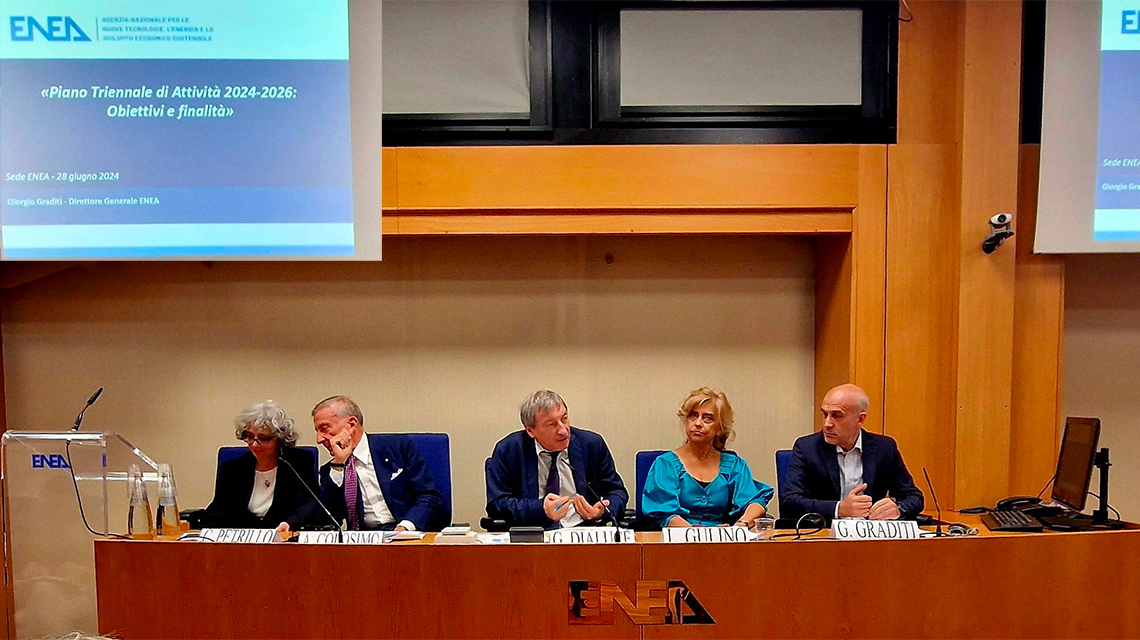Italian National Agency for New Technologies, Energy and Sustainable Economic Development

Research: ENEA Three-Year Plan, 665 million investments and 300 new employees
Met the technical-scientific objectives of the 4 strategic areas of the MASE Directive
Focus on technologies and research in collaboration with national and international partners
On the rise number of projects winning tenders
Presented in Rome by President Gilberto Dialuce and General Director Giorgio Graditi, together with director of the General Administration, Planning and Natural Heritage Department of the Ministry of the Environment and Energy Security (MASE) Loredana Gulino, vice-president of ENEA Board of Directors Professor Caterina Petrillo, and president Antonello Colosimo, magistrate of the Court of Auditors delegated to ENEA control, the ENEA 2024-2026 Three-Year Plan envisages investments for approximately 665 million euro, over 300 new employees and further selective procedures, strengthening of research infrastructures and training courses for staff development and gender equality.
The Plan is ENEA’s main programmatic and strategic document, indicating both the three-year and first year objectives, the funds necessary to achieve them and the personnel needed. Outlining the strategic areas and specific objectives, the document focuses on applied research for the ecological transition, technological innovation, sustainable economic development, support to the Public Administration, also through advanced technological consultancy, the implementation of the Directive issued by the Ministry of the Environment and Energy Security and the PNRR measures.
“The investment plan, addressed to research and service infrastructures, also concerning the development and demonstration of new technologies for decarbonisation and energy and environmental sustainability, will be further developed in the coming years in a consolidated framework in which ENEA has a leading role in the ecological transition process”, said ENEA president Gilberto Dialuce. “The growing activities to achieve the objectives of the PNRR, Mission Innovation, IPCEI and Electrical System Research projects are crucial to face the infrastructural investments planned for the three-year period and promote innovation and technological transfer of research outcomes and products”.
ENEA will focus on strategic themes such as: renewable sources, new energy vectors, hydrogen, biofuels, fusion, advanced nuclear power, energy efficiency, batteries and storage systems, sustainable mobility, energy communities and smart cities, critical infrastructures, smart grid, digitalisation, cybersecurity, circular economy, critical and strategic raw materials, food security, sustainable agriculture, mitigation and adaptation policies to climate change, technical, logistical and operational coordination of the National Antarctic Research Programme, technology transfer and cooperation - also towards developing countries - air pollution and air quality, life sciences, conservation and valorisation of cultural heritage, protection against chemical, biological, radiological risks, metrology of ionizing radiation and space programmes.
Also to mention, the international initiatives in the field of nuclear fusion with the DTT (Divertor Tokamak Test), a large project worth over 600 million euro, with an expected economic impact estimated at 2 billion euro and the creation of 1500 new direct and indirect jobs, the participation in key European consortia and agencies such as EUROfusion, Fusion for Energy (F4E) and the European Joint Program on Radioactive Waste Management (EURAD).
ENEA collaborations with national and international partners have led a greater number of projects to win compared to the previous year and ENEA has provided high-level technological consultancy to the central and field public administration and exceeded its objectives of publications and patents, playing a crucial role in verifying compliance of Superbonus documents, strengthening actions and interventions to valorise and transfer research outcomes to companies and society.
“ENEA is engaged in changing the way in which energy is produced and used and in creating a new energy system, integrating energy sources and carriers with intelligent networks, digitalisation technologies, systems for energy storage and capture and sequestration of CO2 and forms of sustainable mobility that will put people at the centre", pointed out ENEA director general Giorgio Graditi. “Our continued commitment to technological and process innovation embraces all sectors and end uses, including digitalisation and enabling technologies such as Artificial Intelligence, blockchain and the Internet of Things”.
ENEA, which employs 2,211 staff distributed among 9 research centers, 8 large laboratories on a national scale, 17 territorial offices spread over 15 regions, provides the scientific and business community with advanced infrastructures to promote sustainability in the Country, valorising skills and expertise in pursuing research, acting as a link between public and private sectors to encourage the adoption of energy and environmental sustainability criteria in development processes.
